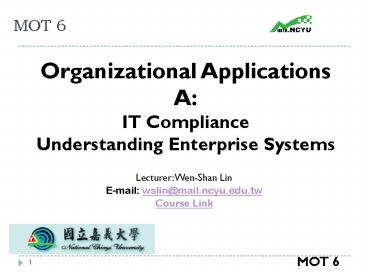Lecturer: WenShan Lin - PowerPoint PPT Presentation
1 / 20
Title:
Lecturer: WenShan Lin
Description:
Describe the benefits and issues of integrating functional ... TPS Computer-Integrated Manufacturing. 8. TPS Product Lifecycle Management. 9. DISCUSSIONS 1 ... – PowerPoint PPT presentation
Number of Views:43
Avg rating:3.0/5.0
Title: Lecturer: WenShan Lin
1
MOT 6
Organizational Applications A IT
Compliance Understanding Enterprise Systems
- Lecturer Wen-Shan Lin
- E-mail wslin_at_mail.ncyu.edu.tw
- Course Link
2
Objectives
- Identify functional management information
systems - Describe the benefits and issues of integrating
functional information systems - Describe the various types of supply chains
- Describe some major problems of implementing
supply chains and some innovative solutions.
3
Case Study Dartmouth-Hitchcock Medical Center
- Problems
- Nurses are in short supply
- Over orders
- Late orders
- Solutions
- Inventory ordering and management system
- Lessons Learned
- IT can support the routine process of inventory
management - The new system helps to modernize and redesign
some of the centers business processes
4
Functional Areas Value Chain Perspective
- The value chain model views activities in
organizations as either primary (reflecting the
flow of goods and services) or secondary
(supporting the primary activities). The
organizational structure of firms is intended to
support both of these types of activities.
5
Functional Areas in a Business
6
Transaction Processing Information Systems
7
TPS Managing Production/Operations Logistics
8
TPS Computer-Integrated Manufacturing
9
TPS Product Lifecycle Management
10
DISCUSSIONS 1
- D1. Why are information systems critical to
sales-order processing? - D2. Discuss how IT facilitates the budgeting
process. - D3. Why is risk management important, and how can
it be enhanced by IT? - D4. How can the Internet support investment
decisions?
11
ERP and Supply Chains
- ERP or enterprise systems control all major
business processes with a single software
architecture in real time. - It is comprised of a set of applications that
automate routine back-end operations such as - financial management
- inventory management
- scheduling
- order fulfillment
- cost control
- accounts payable and receivable
12
ESSENTIALS OF ENTERPRISE SYSTEMS AND SUPPLY
CHAINS
13
Supply Chain
14
Supply Chain Problems
- Demand forecasts are a major source of
uncertainties - Competition
- Prices
- Weather conditions
- Technological development
- Customer confidence
- Uncertainties exist in delivery times
- Machine failures
- Road conditions
- Shipments
- Quality problems may also create production delays
15
Supply Chain Solutions (Continued)
16
Computerized Supply Chains
17
Product Life Cycle
18
Product Life Cycle (contd)
19
Customer Relationship Management (CRM)
20
DISCUSSION 2
- D1. Describe typical supply chain problems and
the reasons for such problems. - D2. Describe solutions to supply chain problems.
- D3. Describe the need for, and types of, system
integration. - D4. Define ERP and describe its functionalities





![DOWNLOAD [PDF] Master Lecture Series for the NCE, CPCE, CECE, and Stat PowerPoint PPT Presentation](https://s3.amazonaws.com/images.powershow.com/10132116.th0.jpg?_=20240917096)

























